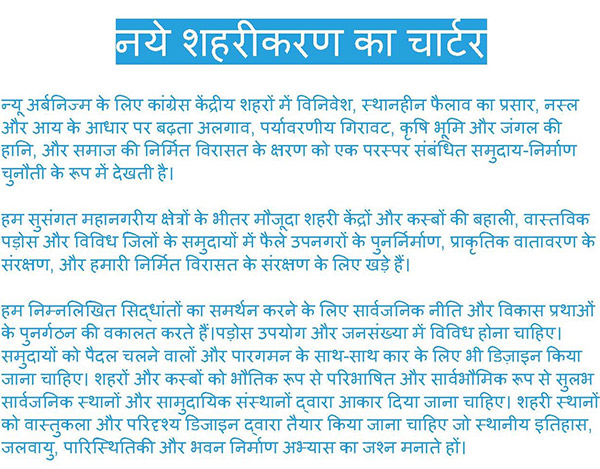Supplementing Architecture Education with Archival Research
Master of Urban Design Student Works in the Architecture Research Center’s Archives
Jenna Courtade

Figure 1- Beginning portion of Dhir’s translation of the Charter of the New Urbanism
I wanted to ensure that we provided a working environment that would benefit her scholarly ambitions, as well as be productive for the archives. With this in mind, Professor Plater-Zyberk and I decided that Shriya would assist me in some archival processing work, but that her primary focus would be to use the archives to write a short research paper. Shriya surveyed, analyzed, and described VHS recordings from the CNU Records collection. For the purposes of the ARC, Shriya’s critical analysis of the recordings provides evidence for the necessity to digitize them for preservation and access. I constructed a methodology that Shriya could easily implement as an initial step in processing this collection. My strategy included the following steps: a pass through to evaluate the physical condition and review of the exterior label; viewing the tapes to reconcile the label descriptions with the actual content; and creating content metadata for the VHS format. Shriya’s analysis advances these materials down the path of eventual digitization and publication.
Shriya’s particular research interest centered on applying the principles of New Urbanism in the built environment of India, her native country. Her comprehensive research of primary and secondary sources within the archives enabled her to contribute to New Urbanism scholarship from a different, yet critical cultural lens. In Shriya’s own words, “This experience allowed me to engage directly with primary materials, offering an unparalleled insight into the evolution and application of New Urbanist principles.”
Working within the Archives, she had the unique opportunity to closely examine the work of Indian architect B. V. Doshi, unraveling the intricacies of his contributions to urban design in the Indian context, and drawing similarities on the focus of people-centered design. Additionally, the collection facilitated an analysis of Charter Award-winning entries from India, enabling her to trace the practical implementation of New Urbanism principles and their impact on the creation of livable urban spaces.
The juxtaposition of theoretical frameworks and real-world applications within the collections proved instrumental in shaping a comprehensive understanding of New Urbanism’s role and efficacy in the Indian urban landscape. This direct engagement with primary materials at the ARC Archives not only enriched her research, but also provided a reflective dimension to the project, offering an appreciation for the dynamic interplay between theory and practice in shaping urban environments. Shriya’s research culminated in the creation of her research paper titled “New Urbanism: A Blueprint of Sustainable Urban Development in India,” as well as a translation of the Charter of the New Urbanism into Hindi (Figure 1).
I asked Shriya a few questions for this blog post, so that she could share her experiences working in the ARC Archives this past semester.
Jenna Courtade: What inspired you to apply for this position?
Shriya Dhir: My keen desire to apply for this position stems from reasons including my academic background, professional interests, and a passion for new urbanism. My academic and professional experiences have equipped me with a solid understanding of the key principles of new urbanism. Hence, I wanted to further engage with the evolving discourse in the field, specifically exploring the linkages between the New Urbanism movement and the Indian context.
JC: What were you hoping to get out of this assistantship?
SD: By actively engaging with the materials at the Archives, I aim to deepen my knowledge of new urbanism and gain a nuanced understanding of urban design. Simultaneously, I seek to explore its practical applications in the Indian context by studying the lessons of new urbanism and drawing similarities between the two contexts.
JC: What is your biggest takeaway from this assistantship?
SD: My biggest takeaway is the background knowledge I could derive, illustrated in my research paper “New Urbanism: A Blueprint of Sustainable Urban Development in India.” Engaging directly with the materials at the Archives has provided me with valuable insights into this influential urban design movement, key figures, and the evolution of community planning. Also, the hands-on experience has honed my skills in archival research, cataloging, and preservation, contributing to my academic growth and professional development in urbanism.
JC: How has this assistantship supplemented your education experience at the School of Architecture?
SD: This assistantship has been a powerful supplement to my education at the School of Architecture, providing a research dimension to the theoretical knowledge gained in academic settings. While my formal education equipped me with foundational principles in urbanism, the assistantship at the Archive of New Urbanism has allowed me to apply and expand upon these concepts in a real-world context. Engaging with the archive’s materials has deepened my understanding of the historical and practical aspects of urban design, bridging the gap between theory and application. This hands-on experience has enriched my academic perspective and my ability to critically analyze and contribute to the broader discourse within urbanism.
Shriya’s work in the archives illustrates the mutual benefits of employing an urban and design planning graduate student to help process architectural archives. She assisted with archival processing; demonstrated the potential of conducting research using the ARC Archives; and supplemented her own graduate school education with hands-on research experience. The ARC Archives is grateful to have Shriya continuing her work in the Spring 2024 semester.